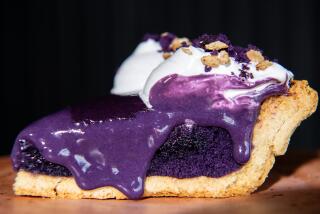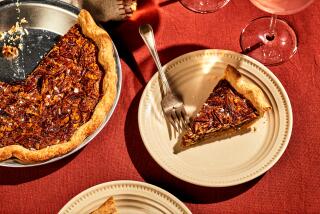PIE CRUSTS
- Share via
It takes just a little practice to turn out an attractive pie with a tender, flaky crust.
Either bleached or unbleached all-purpose flour may be used in the dough. Unless the recipe directs you to sift the flour, simply measure by lightly spooning it into a dry measuring cup, then leveling off with a metal spatula. Measure carefully, being certain not to shake the cup or pack the flour down.
Salt may be added for flavor but is not necessary to the success of the recipe. Blend well with the flour before adding the fat.
Shortening, lard, butter, margarine or oil--any of these fats will give pie crust flavor and flakiness, in addition to promoting browning. Shortening is the most commonly used fat, and it creates a flaky texture but doesn’t impart much flavor. For extra-flaky pastry, chill the shortening 15 to 20 minutes before using. Lard adds flavor, creates a flakier texture than most other fats and may be used alone or in combination with shortening.
Unsalted butter is recommended over salted butter for baking. It gives both color and flavor to a pie crust. Margarine produces a crust similar to one made with butter but without the butter taste. Both butter and margarine should be placed in the freezer 15 to 20 minutes before using and should be combined with shortening. Oil produces a tender pie crust but with a mealy texture.
A pastry blender with arched wires or blades attached to a handle is the best tool for cutting fat into the flour. Using a relaxed flick of your wrist will keep the dough mixture from becoming a compact mass. If necessary, run a finger across the inside arc of the pastry blender to release the shortening.
If you don’t have a pastry blender, two table knives may be substituted, cross-cutting through the flour. It’s also possible to rub the fat and flour together with your fingertips, although the heat from your hands can melt the shortening and may toughen the pastry.
As the fat particles are broken up, they become coated with the flour. Later, as the pie crust bakes, these melt. At the same time, moisture in the dough becomes steam and collects in the spaces left by the melting fat, producing a flaky pastry.
Because the moisture in flour varies, the amount of water combined with the flour-shortening mixture requires some judgment. Enough needs to be added to develop the gluten and hold the flour particles together, but too much will cause the dough to be sticky and the crust to become tough.
Either cold or ice water may be used. The latter produces an extra-flaky pastry.
BASIC PIE CRUST (For Single-Crust Pie)
1 cup flour
1/2 teaspoon salt, optional
1/3 cup plus 1 tablespoon shortening or 1/3 cup lard
2 to 2 1/2 tablespoons ice water
Combine flour and salt in medium bowl. Place shortening on top and, using pastry blender, cut shortening into flour until particles are about size of small peas or coarse meal.
Sprinkle cold water, 1 tablespoon at time, over flour-shortening mixture, tossing lightly with fork to distribute liquid evenly.
Form pastry in ball using hands. Roll out immediately or chill 30 minutes to 2 days.
Makes crust for 1 single-crust pie, about 8 servings.
Each serving, crust only, contains about:
141 calories; 148 mg sodium; 0 cholesterol; 10 grams fat; 11 grams carbohydrates; 2 protein; 0.04 gram fiber.


